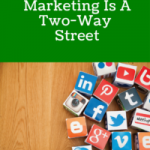Social media has taken the world by storm over the last few years. It not only serves as a great form of public relations for any organization, but as a wonderful way to network, measure your efforts as a business, see what the competition, your peers, and industry leaders are doing. It is a tool to constantly find ways to improve the delivery of services and care you give your clients.
As someone who specializes in the online marketing arena, I meet and chat with people everyday who are interested in using social media to promote their business. But surprisingly many of these people have a major problem in that: they don’t know how to start!
So in this article I want to provide you with a fool- proof step-by-step 101 list to get your social media marketing campaign underway in no time flat!
Step 1: Write Down Your Objectives
The first thing you’ll want to do is identify what you are trying to achieve through using social media to market your company. Keep in mind that more leads or followers is not your only goal. The types of objectives you should be looking at include engaging your current customers/clients, offering better customer service, learning about new services and governmental issues, building brand recognition and getting more local exposure.
Step 2: Know Your Target Market
A social media marketing campaign that is laser focused has the ability to reap better results than a broad shoot campaign. Make a list of 5-10 target markets that you want to hit and keep it handy throughout your campaign. Having this list will help you keep your “eye on the prize”.
Step 3: Look at What Your Competition is Doing on Social Media
Many of us do a competitive analysis when we put together a traditional marketing plan….so be sure to do the same when developing a social media marketing strategy. Usually the easiest way to begin this exercise is to go to the competition’s website and follow their social media links. If you can’t find the links on their website, login to sites like Facebook, LinkedIn and Twitter and search for their company name. Are they getting lots of comments? Do they use lots of graphics and design elements? Are they posting often? Taking a look at these items can give you good solid ideas of what you need to do.
Step 4: What Are You Going to Say?
This is one of the trickiest things to come by as many organizations don’t have a wealth of available info to share. Make sure you are able to come up with content that is timely, engaging, entertaining, thought provoking and educational. Think out of the box! If I was a healthcare organization, I would go to the website for the medical association that is within my niche and share some of their updates and tips, as they would be relevant and interesting to my audience. Sharing is caring….not stealing! But content is king. People write blogs and post information online so it can be shared!
Step 5: Choose Your Sites
Once Steps 1 through 5 are complete, it is time to choose the social media sites you want to start using in your marketing campaign. Every business is different and some will find success quicker on one site than another. There isn’t a hard/fast rule on this. All sites are evolving and making it easier for businesses to get involved. The playing field has changed greatly over the past years (and even months) and there is a spot for everyone on all social media sites. One thing we suggest that you do today, if you haven’t already, is log on to the ‘Big 3’ – Facebook, LinkedIn, and Twitter (and while you’re at it create accounts with Google+, YouTube, and Pinterest – collectively the ‘Big 6’) and stake your username and piece of ‘online real estate’ before your competition does. (Note – this happens often!)
Step 6: Find a Good Support Site
Search and find a site to help you manage your accounts. There are free sites out there such as HootSuite, TweetDeck, SocialOomph, IFTTT and others that allow you to track, search and even schedule profile updates on the fly. When you create your plan, these sites will make it easier for you to manage your overall campaign.
Step 7: Create a Daily Plan to Ensure Consistency
This strategy is key to a successful social media marketing campaign. Your daily plan should contain a combination of Steps 1-6 and have daily time constraints attached. Make sure you identify who will be the touchpoint for the communications you get as a result of the campaign. For example, if you have a marketing team of 5, decide beforehand who will be in charge of delegation and qualification of the leads, information requests, comments, etc. If you’re doing it alone – start with 20 minutes, using a site you’re comfortable with, say Facebook. When you’ve developed a comfort level on one site, gradually add another.
Step 7A – When you’re on social media sites – remember it’s called ‘social’ for a reason. Act the same way you would at a ‘real-time’ networking event or cocktail party. Show up with a goal of connecting with people who can help your business. Reach out and introduce yourself to people and companies that may be within that target audience. Remember there are wallflowers online too! Just as at a party – know that people like to hear about themselves before they hear about you, be sure to comment on their posts, articles, or blogs and make sure to thank them if they comment on yours! Your goal is to take the conversation offline (away from the party) where you can develop a closer and more synergistic relationship.
Step 8: Create a Form of Measurement
This is tricky, so I would suggest waiting until after your first month of social media marketing. At this point you will be able to see what sorts of results come in: website hits, likes, comments, messages, leads, etc. In social media, we like to look at the acronym R.O.I. as ‘Return Of Influence’ rather than ‘Return On Investment’ – as this IS P.R., just as a billboard, tradeshow, or TV commercial – all are difficult to equate the initial outlay to the number of new sales/clients, however with social media you have the results of your influence (likes, comments, shares, etc). Once you get a handle on this, you will begin to understand what generates the best results. Create a quick spreadsheet and track these measurements on a weekly basis. As all of the sites have wonderful archives, it makes it a cinch to go back through the week’s activity to find what you need. If you are going to use your website to track effectiveness, make sure you have an analytics program installed that can monitor where your traffic comes from. If you don’t, Google Analytics is a free and easy option to use (and the results are carefully tracked).
Now you are on your way! The best part about social media marketing is it is an organic process that can change from time to time. Don’t forget to audit your campaign monthly to see if any of your measures or activities need changing or updating. Staying consistent, organized and informed will help you not only launch effectively, but promote your company and business successfully.
“I don’t have time to do this!” you say. That’s where a social media marketing firm may be of assistance. Spending the time doing it yourself does take away from what you do best. Having an entry level person do it can be tricky, as it IS your reputation they’re handling. Dedicating a higher level person or marketing manager may take them away from other marketing and sales opportunities. Although social media works in conjunction with your operations and marketing team, having them do the day-to-day activities may be more costly than outsourcing.
Need Online Marketing Help?
Fill Out the Form Below and We Will Get Right Back to You!
[ninja_forms_display_form id=1]






mark
Apr 13 / 2015Good article. I will be dealing with a few of these issues as well..